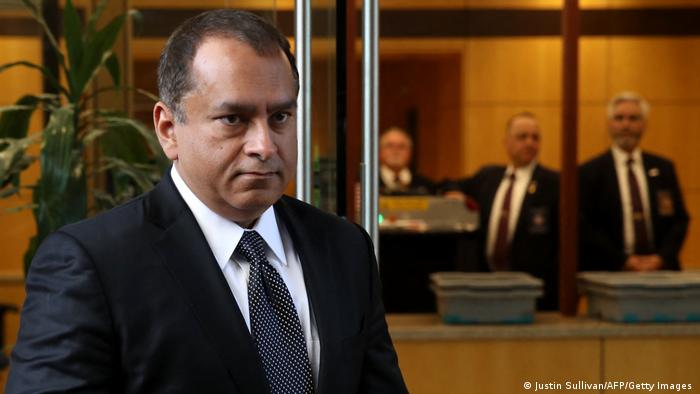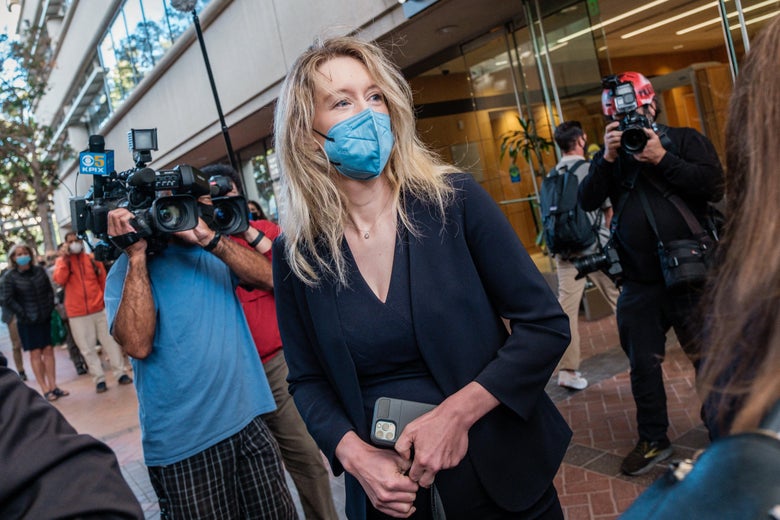United States: Theranos founder Elizabeth Holmes on trial for fraud
With a new type of simple blood test, Elizabeth Holmes wanted to revolutionize the health care industry. Her company Theranos was a Wall Street darling until it was exposed as a fraud. Now she is on trial in California.

Elizabeth Holmes the former CEO of medical startup Theranos knew how to lure unsuspecting investors
It's one prick that can save lives. At least that was the promise that made the founder of the US medical company Theranos, Elizabeth Holmes, look like a prodigy. It was that same promise that made her downfall all the more dramatic.
Just a few drops of blood could be enough to determine hormone and viral loads, discover anomalies and even detect life-threatening diseases with the help of a specially developed instrument. The problem was, the device — with the promising name Edison — never actually worked.
Still for more than 12 years, Holmes successfully tricked companies, money managers and billionaires into believing that Edison was so efficient and inexpensive that the company would not only make blood testing easier, but also replace time-consuming and expensive laboratory tests forever.
The American drugstore chain Walgreens even offered the testing service in 40 of its stores in Arizona and California. It is thought that hundreds of thousands of customers received inaccurate and sometimes dangerously incorrect blood results.
Bring light into the dark
The fact that the scam was exposed is mainly attributable to John Carreyrou, an investigative journalist at the Wall Street Journal. About six years ago, he received a call from a former employee who told him what was going on at the company. His research, interviews and publications went a long way toward unmasking Holmes.
In 2018, she was indicted by the Department of Justice. Federal prosecutors accuse the 37-year old of defrauding investors, doctors and patients. Now she is to stand trial on 12 counts of fraud and conspiracy to commit wire fraud. She has plead not guilty.

Elizabeth Holmes with her supposed revolutionary blood test
The trial is now getting underway with the selection of jurors. The company's former president, Ramesh Balwani, who was also her boyfriend for a while, will also soon be sitting in the dock. If the court finds either guilty, they face up to 20 years in jail and fines of more than $2 million (€1.69 million) each.
A central question in the case will be whether the entrepreneurs acted deliberately in order to steal investors' money under false pretense. One focus will be on their luxurious lifestyles, which presumably made both of them increasingly greedy. The prosecutors are therefore calling for specific and sometimes intimate details from Holmes' life to be disclosed. Above all, traveling in private jets, expensive shopping tours and regular stays in luxury hotels.
Getting in the black
Holmes knew how to cast a spell over investors. On stages, at lectures or meetings, she deliberately changed her voice to sound deeper and more serious. Her appearances almost always mirrored those of her role model, Apple founder Steve Jobs, who also influenced her choice of clothing. Her closet was full of black clothes and turtlenecks, which would make it easier for her to choose what to wear in the morning and not waste unnecessary energy.
She was particularly able to wrap influential and wealthy men around her finger. The Theranos supervisory board included statesmen such as ex-Secretary of State George Shultz, former Defense Secretary James Mattis and even Henry Kissinger. The investors, in turn, included prominent names like media mogul Rupert Murdoch, Silicon Valley investor Tim Draper and the Walton family, founders of Walmart.
Blinded by the vision and without much scrutiny of the books, they invested more than $700 million in the medical startup. At the height of its success in 2014, Theranos was valued at a whopping $9 billion. A year later, Time magazine named Holmes one of the 100 Most Influential People in the world. She was regularly featured on the covers of popular business magazines.

From shooting star to bankruptcy. At its peak Theranos was valued at $9 billion
200 tests in a small box
What many did not see — or did not want to see — became apparent to critics like journalist John Carreyrou. For example, the Edison device was extremely simple. In reality, the machine consisted of a robotic arm and countless pipettes that were lined up inside the crate-sized machine. Carrying out more than 200 different blood tests in such a machine was simply impossible, which is why Theranos secretly used competitors' machines. But Holmes never let on to the switch.
She always said that she was on to something very big and therefore didn't want to reveal details. When asked about the basic design though, she showed how little she actually knew about the technology.
"It sounded like the words of a high school chemistry student as opposed to a sophisticated laboratory scientist who'd really invented new science," Carreyrou wrote in his book Bad Blood: Secrets and Lies in a Silicon Valley Startup, in which he deals with the case.
Holmes, on the other hand, has been unapologetic. With the help of some of the best lawyers in the country, she put legal pressure on all those who wanted to testify against her or bring her company into disrepute. She labeled many as envious while she apparently continued to believe in her vision.
"This is what happens when you work to change things. First, they think you're crazy, then they fight you, then all of a sudden you change the world," she said on CNBC in 2018.
A new baby on board
Holmes is expected to rely on confrontational tactics in court. In the past few days, the number of potential jurors has been reduced after her lawyers complained that the majority of them were biased.
"Thirty to 40 of the jurors have consumed substantial, and I mean lengthy extrajudicial material, about the case and about the defendant," attorney Kevin Downey told the judge. It is already becoming apparent that it will be a lengthy trial.

Former COO Ramesh Balwani will also soon be on trial
Holmes herself is going on the offensive. On the weekend, news came out that she will say she was the victim of a decade-long abusive relationship with former COO Ramesh Balwani. According to documents, she plans to have an expert testify about the psychological, emotional and sexual abuse that she went through. It was Balwani, according to Holmes, who first controlled her and then manipulated her.
It is questionable, however, if this tactic will work. Holmes has already had to answer for her actions several times and has taken some of the blame. In order to avoid a lawsuit in 2018, she agreed on a settlement with the US Securities and Exchange Commission, which said she "made numerous false and misleading statements in investor presentations, product demonstrations, and media articles" about their key product. Holmes then paid $500,000 and agreed not to run a public company in the next 10 years.
What could benefit her most is the fact that a few weeks ago she gave birth to her first child. Planned or unplanned, many consider it a smart move. "Being a new mother can only help get her sympathy from jurors," said legal analyst Danny Cevallos on NBC News. "If convicted, even if her sentencing guidelines call for incarceration, her attorneys will place her motherhood front and central before the judge."
BY AARON MAK

Jury selection for the trial of Elizabeth Holmes, founder and CEO of the disgraced blood-testing startup Theranos, began on Tuesday. Federal prosecutors have charged Holmes with multiple counts of fraud and conspiracy, alleging that she misled patients, doctors, and investors about the effectiveness of her company’s technology, which could supposedly diagnose a wide variety of medical conditions with a finger prick. Investigations by the Wall Street Journal and federal officials beginning in 2015 found that Theranos’ devices were providing inaccurate results, and that in many cases the company was using its competitors’ technology to run tests with diluted blood samples. Over the weekend, unsealed court documents revealed Holmes’ planned defense: that emotional and sexual abuse from Ramesh “Sunny” Balwani, the former president and chief operating officer of Theranos, during their romantic relationship impaired her mental state.
Holmes, 37, and Balwani, 56, worked together closely to build up Theranos and maintained a secret relationship during that time. They first met in Beijing while Holmes was attending a Mandarin language program in the summer before her first year at college, and they later formed a partnership in leading Theranos in which Holmes reportedly handled big-picture ideas and the board of directors, and Balwani oversaw partnerships and day-to-day operations. Filings indicate that she intends to accuse Balwani of controlling and manipulating her by withholding affection if she displeased him and dictating how much she could eat, what she wore, how much she could sleep, and whom she could speak to. She is also prepared to claim that he threw “sharp, hard objects” at her. Holmes’ lawyers wrote in a court document, “This pattern of abuse and coercive control continued over the approximately decade-long duration of Ms. Holmes and Mr. Balwani’s relationship, including during the period of the charged conspiracies.” Her lawyers also plan to have Mindy Mechanic, a psychologist who specializes in intimate partner abuse who evaluated Holmes, testify during the trial.
While Balwani has his own trial next year for alleged crimes committed as a Theranos executive, it is Holmes whose face, name, and voice became practically synonymous with the company. Reporting on the rise and fall of Theranos has often portrayed Holmes and Balwani as collaborators in the alleged deceptions. So Holmes’ legal strategy may come as a surprise. But could it work?
By raising these abuse allegations, Holmes is mounting what’s known as a “mental disease or defect” defense in which she’s arguing that she can’t be held responsible for her actions because of the trauma from the relationship. “If a jury finds that she has proven this, it’s essentially finding that because of a severe mental disease or defect, she was either unable to appreciate the nature of her acts or the wrongfulness of her acts,” said Miriam Baer, a professor at Brooklyn Law School who specializes in corporate and white-collar crime. The accusations against Balwani complicate what otherwise might’ve been a traditional fraud case in which the government would set out to show what Holmes knew, analyze ways in which her statements were allegedly misleading, and perhaps brings up ways in which she tried to conceal certain information. Holmes’ defense partly shifts the narrative away from fraud. “This claim of intimate partner abuse introduces a whole new narrative, and that narrative has the potential to cause the jury to question the story that they hear from the prosecution’s witnesses,” said Baer. “That means the jury is potentially going into that deliberation room unsure of what really happened, and that lack of certainty and ambiguity can’t help but benefit the defendant.”
This kind of defense is fairly unusual, particularly in corporate cases. “The classic case is an abused partner then harming or killing the abuser,” said Thomas Joo, a professor at the University of California–Davis school of law who specializes in white-collar crime and corporate governance. In order for this defense to succeed in Holmes’ case, her lawyers have to first prove that the abuse actually happened, and then show that it in fact influenced her to lie about Theranos’ technology. Joo notes that this strategy may be more effective in neutralizing allegations of misleading investors than of misleading doctors and patients. “Balwani appears to have been the finance person, and he’s not a scientist, so the idea that he manipulated her may be a stronger argument with respect to statements she made about finances, because he controlled that area,” Joo said. “With respect to the patients and doctors, the financial health of the company is not relevant. It’s really about whether the product worked or not.” Balwani initially joined Theranos in 2009 to help with its e-commerce operations after working at Microsoft and Lotus as a software engineer. He quickly rose the ranks of the company to become one of its top executives, though Holmes was clearly the face of the company in the media, and famously convinced famous figures like George Shultz to invest and serve on the board.
POPULAR IN TECHNOLOGY
Which Elizabeth Holmes Will Show Up at Her Trial?
It’s unclear how Holmes’ defense will play out in the court room because we don’t know what and how much evidence her lawyers are planning to present regarding the alleged abuse. The strategy does have its risks, though, partly because Holmes’ lawyers have to do the extra work of proving something rather than just casting doubt on the prosecution’s arguments. “The defense is difficult to prevail on; it requires the defendant to prove it with clear and convincing evidence,” said Baer. “It’s such that it may result in a defendant deciding that he or she would be best served by testifying, which can itself open up new problems.” Indeed, defense lawyers are typically wary of having defendants take the stand because it opens their clients up to cross examination. At the same time, though, the strongest evidence that Holmes’ lawyers can introduce to prove that she was psychologically damaged due to abuse is likely her own personal testimony. “It’s always an enormous risk when a defendant testifies, but in this case, it appears that the jury will likely be very eager to hear her side of the story,” said George Demos, a former Securities and Exchange Commission enforcement attorney and adjunct professor at the UC–Davis School of Law. “The big risk for Holmes is that if she lies about anything on the stand, no matter how seemingly irrelevant, the jury will then conclude that she’s lying about the underlying charges in the case.” Demos adds that the prosecution is likely to try to poke holes in the defense’s claims about her mental state and lack of agency by examining “evidence about her control of communications, employment decisions, legal matters, and other financial decisions that would demonstrate that, in fact, she was the one in control and making the decisions, not Sunny.”


















